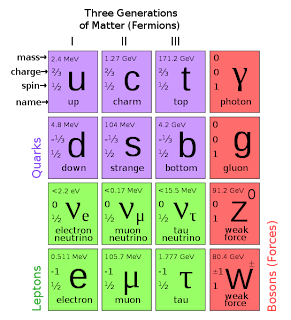For myself understanding the dimensional relationship toward the QFT perspective of particle research and development, it has been a difficult road to understanding this relation. It is not just the idea of what transpires as we architecturally build the world\universe we live in, but to understand nature's expression as we see the movement in the universe as we research and experimental with particle decay products.
| Click on Image to go to appropriate site for image dedication |
So there is a lot being said about what is contained in the first paragraph of this opening blog post that will never be understood by other layman like myself, or, other experts considering the developmental phases I have been going through. Are my ruminations consistent, or, have they haphazardly layered a trail of confusion to have it said that what danger lurks in this determination of what is written here is to confuse.
Should I put aside all that I have learn in context of theoretical developments?
| Albrecht Dürer(self portrait at 28) See also: Albrecht Durer and His Magic Square |
No. I can assure you that I have been at this a number of years now to say that with what I am doing now is filling in the gaps of where I have been to where I am going in terms of better explaining myself in a scientific context that is acceptable to the notion of what might have transpired in the 21 st century for some. It has been in learning string theory. Yes, I have listened to all the articulations of the back and forth of what the basis of this theoretical determination is "as a mathematical foundation" has yet to prove it''s validity as a method by which to explain the nature of the universe?
Physicists Andrew Strominger and Cumrin Vafa, showed that this exact entropy formula can be derived microscopically (including the factor of 1/4) by counting the degeneracy of quantum states of configurations of strings and D-branes which correspond to black holes in string theory. This is compelling evidence that D-branes can provide a short distance weak coupling description of certain black holes! For example, the class of black holes studied by Strominger and Vafa are described by 5-branes, 1-branes and open strings traveling down the 1-brane all wrapped on a 5-dimensional torus, which gives an effective one dimensional object -- a black hole.
How am I to dismiss the logic of approach? We are learning to count in dimensional referencing? It is mathematically orientated is it not? But indeed, Planck scale presents a problem. So by what foundation can it ever play as a method by which such discussion of the universe in expression? How can it have such validation as a geometrical expression of the nature of particle expression by virtue of the dimensional development along side of topological arrangement and correlations?
The crystalline state is the simplest known example of a quantum , a stable state of matter whose generic low-energy properties are determined by a higher organizing principle and nothing else. Prof. Robert B. Laughlin
This is just the road I took and it allowed me to see what can ever transpired as a expression of a understanding of symmetry breaking. It is an understanding of this correlation toward the "false vacuum to the true." This was an expression of the space we are "living in" as an understanding of the timing in relation to the expression of this universe. One just had to know indeed their was indeed a higher order? A Klein bottle perhaps in following the lines on the surface?
Using the anti–de Sitter/conformal field theory correspondence to relate fermionic quantum critical fields to a gravitational problem, we computed the spectral functions of fermions in the field theory. By increasing the fermion density away from the relativistic quantum critical point, a state emerges with all the features of the Fermi liquid. See:String Theory, Quantum Phase Transitions, and the Emergent Fermi LiquidWhat can we say then is emergent? So you are learning to count in geometrical expressions as a placement of the Genus figures? So what correlations can be drawn toward the beginning of such counting?
For me it was necessary to carry on the tradition of geometrical seeing what was revealed in relativity development(Grossman and Riemann) to know that such an expression had to be moved into the world of the very small.
 |
The Landscape Again and again.... |
It had to have a relativistic interpretation of the way in which such energies could detail the understanding of particles in expression. But also, of the energies involved. So this "Royal road to geometry" in relation to topology, had to be understood by myself as I understood the Genus placements in the valleys of expression. The landscape.
I knew where such new physics needs to be in relation to what is happening as we look at the experiments of LHC . Of course I have to better understand the Jet manifestation in order to reveal some of the thinking that has been produced in my journeys.















